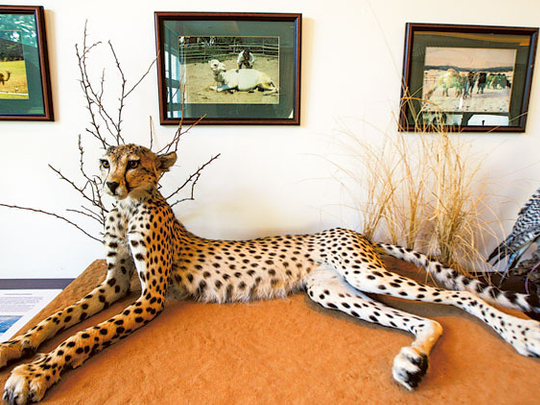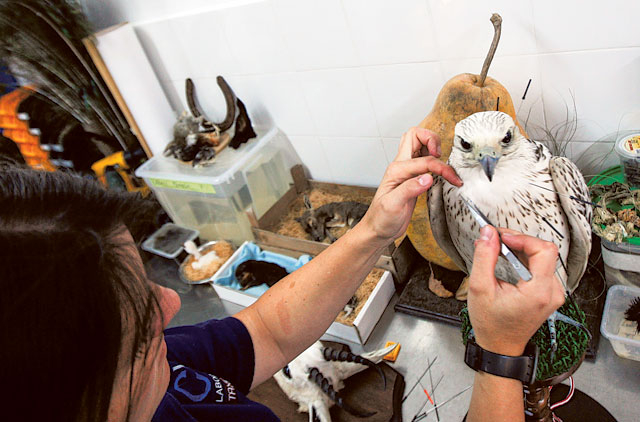
If your friends raise eyebrows at the dead animal in your majlis, tell them to get stuffed.
Taxidermy is slowly grabbing a pawhold in the market here: there is a two-year wait to get your animal stuffed in Dubai and it’s going to take a big bite out of your wallet.
While demand for stuffed animals remains lively, people in the UAE still need a better understanding of taxidermy, local taxidermists say.
“People don’t trust it, they say it’s offensive, but how? The animal already exists,” argues Abdullah Mohammad Al Ali, the Emirati owner of Al Maha Taxidermy shop in Abu Dhabi.
There he turns dead animals into hunting trophies and ornamental pieces for homes.
His clients include royal families, taxidermy collectors, farm owners, animal breeders, government authorities and museums.
“Business is improving day by day but there is not a lot of growth. It’s not a service demanded daily and it’s specific to hobbyists,” he said.
Last year Al Ali sold about 60 pieces, about the same as business the year before.
Prices range with the size and position of the animals. A lion can cost about Dh100,000, an impala for Dh50,000 and a rhino at a whooping Dh250,000, he said.
The rarest piece his team from South Africa worked on was a snow leopard brought in by a local customer.
Best-sellers include falcons and local gazelles such as Al Reem and Al Domani that sell for Dh7000.
Sometimes clients bring in their own animals but Al Ali also imports animal skins from Africa and mounts them locally, saving clients the cost of going hunting abroad, he said.
Most animals end up in majlises around the UAE as ornamental pieces, taxidermists say.
Most of Al Ali’s clientele are men, but recently a growing number of women are interested. “They usually want small, colourful pieces for home decoration,” he said.
The market could use a boost with more natural history museums and professional taxidermists, local businesses say.
“I expect the market to get better. It’s new now, so it’s still slow. It needs time for people to get used to the idea and connect to the wildlife. We don’t have much of that in the UAE, people are far from nature,” Al Ali said.
The biggest challenges to taxidermy are changing people’s attitudes towards it, the lack of supplies available locally and the increasing costs of importing them, he said.
Last year, the cost of supplies rose by 20 per cent but Al Ali chose to keep prices at the same level to attract more customers.
A door slides open and we are standing face-to-face with a female white lioness gazing steadily at us with sharp blue eyes in the middle of a quiet compound in Za’beel.
The feline beauty is startlingly life-like, just seconds away from swishing its tail and sauntering over.
The lioness is the latest project that taxidermists Corina Berners and Andre Appelt are tackling at the Central Veterinary Research Laboratory (CVR), a diagnostics centre founded in 1985.
They have a waiting list of two years to stuff animals, Berners said.
“In this area demand is quite healthy but hunting taxidermists won’t find work,” she says.
Business has slowed down by half in the last decade as new regulations helped to protect the animals and environment, she added.
Berners expects prices of stuffed animals to go up as the cost of supplies increase and taxidermy technology improves. CVR increased its prices by 15 per cent in 2012 to cover energy and materials costs.
In the past year they stuffed about 60 to 70 animals including exotic ones such as sloth, Arabian leopard, porcupine, rare reptiles and a giraffe—their most challenging project to date.
So why do people stuff their pets?
“To keep them over death because they love them. They see the beauty in the animals and keep them at home. They are more than just an ornament in the majlis,” said Appelt.
Creepy as it may seem to some, taxidermy offers us the opportunity to visually educate children about animal species, have a record of rare animals and a cautionary tale about extinct species, Berners says.
“I can understand everyone who feels taxidermy is creepy. If you have pets at home you don’t want them stuffed hanging on the wall later or I if I would go to the forest, instead of shooting an animal I’d just watch it,” she says.
There’s a fascination with the beast during the process.
“When we stuff an animal we do a lot of research first and then you have all this interesting information on it, then it just can’t be creepy anymore. You read how old they get, how they mate, how many offspring, all these things, how they survive in their special environment. Every animal has something that makes it so special, so interesting, then it just can’t be creepy anymore,” she says.
The centre refuses any animals that were hunted, killed or injured for ethical reasons and requires legal paperwork to be presented before agreeing to stuff the animal.
For both Berners and Appelt, taxidermy is not the butcher job that some imagine it to be but rather an artistic craft.
“We touch them with respect, it’s not just throwing around a dead carcass,” Berners says.
“It’s always a piece of art,” Appelt chimes in. “We’re taking a tiny bit of nature and preserving it for hundreds of years.”
Rachel Poliquin, author of The Breathless Zoo: Taxidermy and The Culture of Longing that will be published in August, poses a new idea about the fascination with taxidermy.
“I suggest that taxidermy is always entwined with the enduring human longing to find meaning within the natural world. By drawing out the longings at the heart of taxidermy—the longing for wonder, beauty, spectacle, order, narrative, allegory, and remembrance—I explore the animal spectacles we desire to see, human assumptions of superiority, the yearnings for hidden truths within animal form, and the loneliness and longing that haunt our strange human existence, being both within and apart from nature,” she says.














